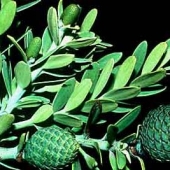Please select root levels for the menu
NZ Plants
Podocarpus totara - tōtara
Podocarp family: Podocarpaceae
-
Mature foliage
L Jensen
View picture -
Mature foliage, leaf detail
I MacDonald
View picture -
Mature foliage, stem detail
L Jensen
View picture -
Mature foliage, upper surface of leaf
L Jensen
View picture -
Mature foliage, lower surface of leaf with rows of stomata
L Jensen
View picture -
Stomata
L Jensen
View picture -
Juvenile foliage, leaf detail
I MacDonald
View picture -
Bark
L Jensen
View picture -
Branch with pollen cones
L Jensen
View picture -
Mature pollen cone
L Jensen
View picture -
Pollen cone, detail
L Jensen
View picture -
Young ovule cones
L Jensen
View picture -
Cone at time of pollination. The ovule is subtended by fleshy bacts.
L Jensen
View picture -
Ovule with micropyle
L Jensen
View picture -
Young seed cone. The subtending bracts enlarge and begin to change colour.
L Jensen
View picture -
Maturing seed cone
L Jensen
View picture -
Mature seed cones with seeds sitting above the fleshy red, fused bracts.
J Braggins
View picture
Podocarpus totara is a tall forest tree with brownish green foliage of rigid, linear needle-like leaves and a bark that separates into long narrow strips. Small, fleshy ovule cones are formed in which a green epimatium (an outgrowth of the seed scale) covers the developing seed. After fertilisation the bases of the fertile and sterile bracts fuse and become fleshy to form a red receptacle (or 'foot') situated below the seed.
An endemic species found throughout New Zealand from lowland to mountain forest.
More on tōtara: Takana Newsletter
Vegetative characteristics |
Reproductive characteristics |
|---|---|
Adult plant form: tree up to 35 m |
Pollen and ovule cones: on separate trees |
Adult leaf form: linear, rigid with sharp tip |
Pollen cone: 10-15 mm long |
Adult leaf size: 15-30 x 3-4 mm |
Ovule cone: 5-8 mm long (?), 1-2 fertile bracts |
Adult leaf arrangement: singly along the stem |
Ovule position: terminal on a short stem on the upper surface of a fertile bract subtended by fused sterile bracts (receptacle) |
Juvenile leaf form: no distinct juvenile form |
Ovule coverings: an inner covering (integument); an outer covering (epimatium) covers the entire ovule; |
Juvenile leaf size: 15-20 mm x 1-2 mm |
Ovule pore (micropyle): directed downward |
|
Mature seed cone: fleshy, 10-15mm long, 1-2 seeds |
Stem(receptacle) below seed: fleshy, derived from basal bracts of the receptacle; red |




